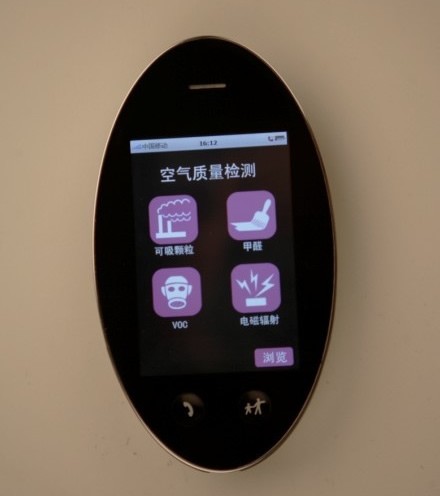Engulfed by air pollution, Beijingers turn hi-tech

BEIJING -- Beijingers are used to polluted air, but the smog engulfing the capital earlier this week was especially unpleasant. Visibility shrank to a few hundred meters, grounding more than 200 flights at Beijing’s capital airport, and leading to the closure of 6 highways in the capital.
Beijing’s official data rated pollution levels as “slight,” while the city’s daily newspapers described the atmosphere has “foggy” rather than polluted. Beijing has less rigorous standards for measuring pollution, and does not currently release data on a kind of pollution known as PM2.5, which consists of small particles measuring less than 2.5 microinches across, which is considered to be the most damaging to human health.
Beijing’s educated, white collar workers looked to the Chinese version of Twitter, Weibo, for more accurate information. “I’ve been reading posts about PM2.5 levels on Weibo,” Zhou Yuan, who works at a multimedia company in Beijing said. The PM2.5 statistics are sourced from the US embassy, which runs its own pollution monitoring station in Beijing.
“Levels of pollution are dangerous,” she said. “My main worry in the long term is getting lung cancer.” But not everyone is equally concerned. “People who use the internet at work can find out the real pollution levels,” Zhou said. “But elderly Beijingers don’t have the chance to read about it.”
Cao Xiaoli moved from the countryside to open corner store in Beijing two years ago, and doesn’t have a Weibo account. “This is fog,” she said. “It's a natural at this time of year, I don’t think it’s unhealthy.”
A few Beijingers are determined to increase awareness of air pollution. Wang Qiuxia, a volunteer for environmental NGO Green Beagle, coordinates a scheme which lends a PM2.5 monitoring machine to ordinary Beijing residents.
“A lot of Beijingers know the air is bad, but they’ve never heard of PM2.5” she said. So far, Wang has lent the device to around 20 people, encouraging them to test the air in their homes, on public transport and on the streets. “We want people to experience for themselves how bad the air is,” she said.
Concerns about health, and gaps in official statistics, mean potential profits for some. One company eager capitalize on worries about air quality is air conditioning firm Broad Group, based in Central China. Their flagship air purifier retails at around 10,000 RMB (about $1500 USD), and the company’s website boasts that it supplies the purifiers to the offices of China’s central government.

But the company’s biggest innovation may be the “Broad Life Phone,” which is fitted out with air pollution monitoring equipment. The egg-shaped device can check levels of atmospheric dust, as well as radiation from electrical equipment. “We hope to have it on the market by next month,” Broad Group’s vice CEO Peng Ji told local media.
“The phone hasn’t been officially approved by the authorities,” he said “but that won’t affect the public’s ability to measure and assess atmospheric quality.”
Though a spokesperson from Beijing’s environmental bureau stated that they are ready to rate the city’s air quality according to PM2.5 levels, it's still unclear when the data will be made public. Until then, Beijingers who want to know the true extent of atmospheric pollution in their city will continue to be left to their own devices.
Photos: NRDC; Engadget.
This post was originally published on Smartplanet.com